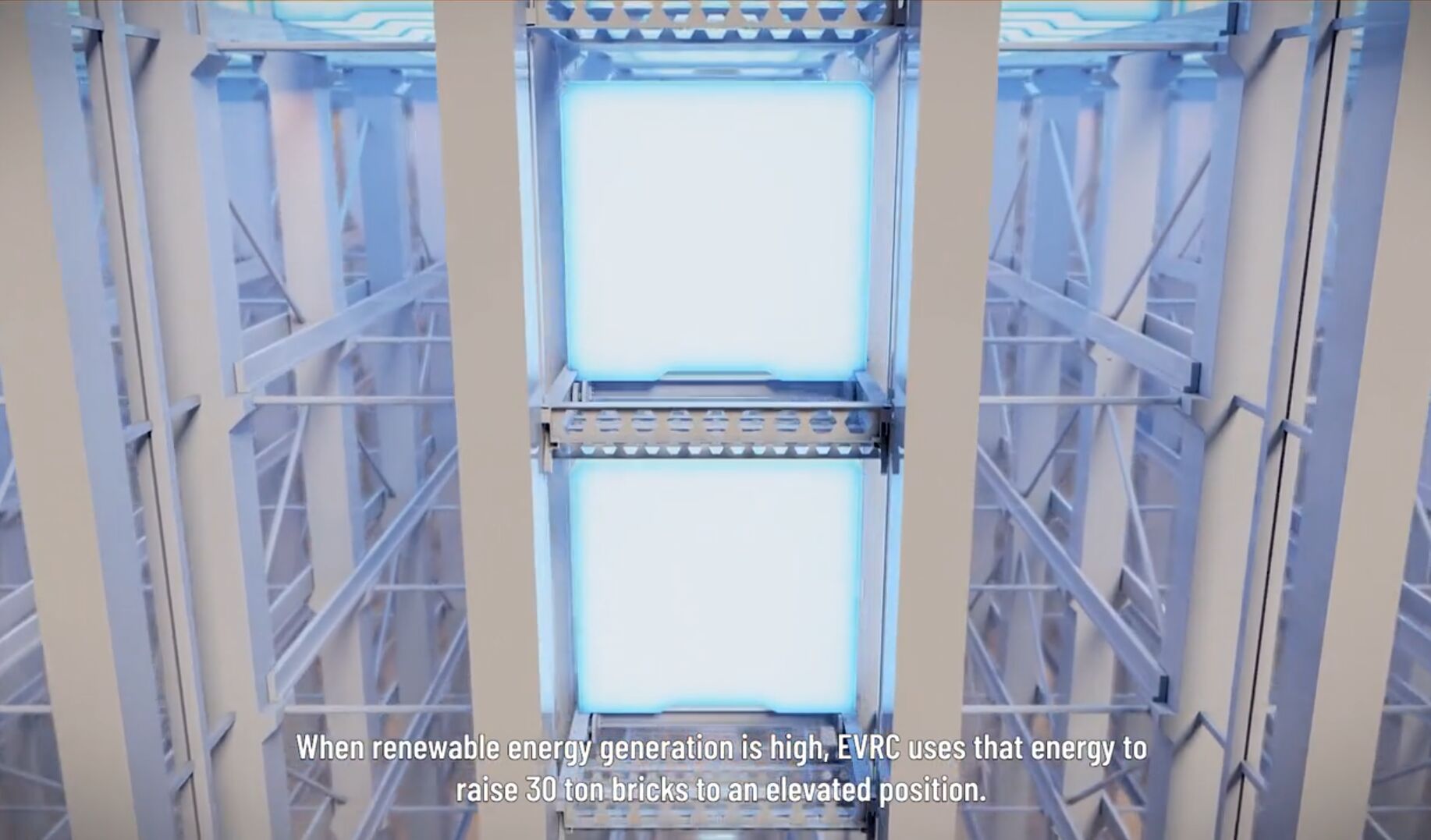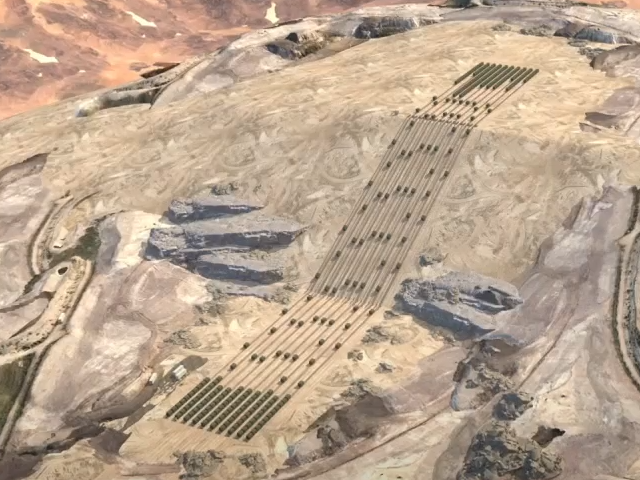A year ago I wrote “eco: energy storage is hard, gravity storage as a game”, using physics and a units calculator to show how hard it is to profitably store energy using gravity. Gravity storage isn’t a scam, but nothing besides pumped hydro at suitable sites where Mother Nature provides the vertical drop, the upper and lower storage areas, and millions of tons of working mass is likely to ever be financially viable. Time for an update.
Energy Vault switches from Jenga tower to fuzzy building
After building a prototype of its punishingly expensive high-maintenance crane exposed to the elements that has to precisely build and dismantle towers of blocks for decades, it looks like reality has whupped Energy Vault upside the head and made it shift gears. It’s given up on the open-air Jenga tower; I wonder if its triple-crane quarter-scale prototype is still standing in Switzerland. It’s now promoting an enormous EVx building 100 meters tall and 300 meters on a side to store 1 GWh of energy.

But physics hasn’t changed. Using our trusty units calculator again, each 35 tonne block hanging from the ceiling has this much potential energy:
Convert: 35 tonnes * gravity * 100 meters
To: kWh
⟶ 9.5342431 kWhSo to store 1 GWh of energy, it will have to hang 100,000 blocks from the ceiling, 3,500,000 tonnes. Elon Musk’s SpaceX can quickly build a “mega bay” for rocket assembly that’s 81 meters tall and 30 by 25 meters, but its bridge crane only has to lift up empty boosters weighing about 200 tons; hanging 3.5M tonnes from the ceiling (how?) seems a lot harder. If this building is going to be able to quickly “charge” and “discharge,” it’s going to need many cranes: a single block raising or lowering in 20 seconds requires or delivers 1.7 MW of power. It looks like there are 16 piles of… something… inside the big building, so lowering a pair of blocks at a time from each delivers 50 MW. If the building slowly stores and releases energy it doesn’t need so many cranes, but then it will make less money each year.
My first guess: a hanging forest
Energy Vault’s outdoor crane had the problem of each block gaining and releasing less potential energy as it dismantles the Jenga tower. I thought it would be really challenging to store multiple layers of blocks, so I thought they would store them all at one level. 100,000 blocks is 316 on a side, so each block has to be less than 1 meter square for all of them to fit in a 300×300 meter roof. Rock and concrete both weigh around 2.4 tonnes per cubic meter, so if each block is 0.9 meters on a side, each would have to be
Convert: 35 t / (0.9 m * 0.9 m * 2.4 t / (m^3))
To: m
⟶ 18.004115 m60-foot tall thin concrete needles might hang OK, but how would you keep them upright when lowered?
Energy Vault’s fantasy: automated Amazon warehouse meets Willy Wonka’s elevator
Since I wrote that, Energy Vault has released a new video with CGI of the building. The video shows pairs of mystical glowing 30-ton blue blocks lifted up and down relatively small heights in its EVx building by a double-height elevator, then somehow each block magically rolls out on dedicated wheels to wait high up in the world’s most uniform warehouse.

That reduces cracking and chipping, but now every 30-ton block of “local materials” has an undercarriage. Roughly costing this stuff is a fun exercise; Henan and Perfect make warehouse rail transfer carts and platform trucks that can support 30 tons for unknown prices. But just a basic 2 1/2-ton rolling cart costs $1,000, so it’s not going to be cheap. Amazon can afford to optimize materials handling in an automated warehouse when each pallet holds $thousands of valuable goods, but scaling up the same technology to 120,000 30-ton carts each storing a dollar of electricity is… dubious. It’s like Energy Vault saw the elevator in the Willy Wonka remake, confused it with some warehouse automation videos, and thought “We can do that with gravitational potential energy and get rich while having fund building stuff.” Are investors like Bill Gross of Idealab, Palantir, and infamous Softbank really so clueless about the basic physics of mass * gravity * height to fall for this?
Ares builds the world most boring roller coaster
No more gravity choo-choo train…
ARES (Advanced Rail Energy Storage) planned to roll train cars full of heavy crap up and down an abandoned railway in Nevada “with operations beginning in early 2019”. It would only deliver 50 MW and store 12.5 MWh, far smaller than most commercial battery storage system already up and running. “They move up and down an 8-degree slope with an elevation change of about 3,000 feet”, which means this much stuff has to be hauled up and down:
Convert: 12.5 MWh / (3000 feet * gravity )
To: tonnes
⟶ 5018.2884 tonnesAnd it also means the track is this long:
3000 feet / sin (8 degrees) = 6.5702352 kilometersChoo-chooing 5,000 tonnes of crap up a 7 km railway line is plausible, but presumably the high cost of electrifying the track and operating the trains doomed that project iteration. You can order a Tesla Megapack today for only $6.8M that delivers 6.5 MW and stores 12.8 MWh; slightly cheaper to deliver the same power and much cheaper to store the same energy.
… instead 350-ton mass cars!
So ARES now plans to drag a fleet of 210 “mass cars” each weighing 350 tonnes (!! 11 times heavier than Energy Vault’s latest glowing blocks) up and down the side of a working gravel pit, still in Nevada. ARES claims the same 15 MW/50MWh power and energy, but you can see the problem from its own (computer-generated) photos:

The pit isn’t very deep, so ARES needs hundreds of these crazy heavy cars to store the energy, and has to run 10 tracks each lowering 4 cars at once to deliver the power. But because the plant is much more compact it doesn’t have the cost of electrifying miles of railway line.
The custom-built mass cars on custom double-width rails will be hauled up the hill by dual chain drives, just like a roller coaster. But the pair of chains required to deliver 5 MW of power to yank 1400 tonnes up a hill seems a daunting engineering task. I tried to find a chain drive that can deliver this and got lost in complicated chain specifications and “engineering handbooks for chain drives”; each chain will undoubtedly be extremely heavy and require supporting bearings just to hold it up along the length of the track.
Gravity Energy Tycoon Simulator, please!
As I said last time, someone should make a simulation game for these gravity storage systems that challenges you to actually make money.
2023 update: also, the embedded CO2 aspect
Michael Barnard at CleanTechnica has also analyzed Energy Vault’s dumb idea and found it colossally stupid. “The initial concept [of the cranes stacking and unstacking blocks] was terribly silly in obvious ways”, and the building has its own problems. One thing I didn’t consider was the carbon debt of making the building and the blocks. Despite the blatant lies from fossil fuel companies, a solar panel or wind turbine generates far more energy than it took to make it, so the “embodied carbon” of their production and lifetime operation results in very low CO2 emissions per kWh generated. But making thousands of 35-ton blocks and a building and metal structures that can lift and keep them in the air on tracks will generate tons of emissions, and at the paltry energy generated with each lift, it will take a long time to offset that, so the CO2 emissions per kWh are really high. It’s hard to summarize his analysis leading up to “CO2e per kWh numbers worse than natural gas generation, and makes a mockery of their claims of low cost storage”, go read it.
He then followed up with an article dismantling Energy Vault’s false claims that its solution is better than pumped hydro, “Energy Vault Claims Highlight The Lack Of Due Diligence In Cleantech SPACs“. The dual tragedy is first supposedly smart tech people like Bill Gross and Bill Gates invest in startups pursuing dubious breakthroughs, and then clueless investors put money in them when they go public through a Special-Purpose Acquisition Company. The latter should be illegal; the acquiring company doesn’t have to publish an initial public offering prospectus where it details all the risks and challenges facing the startup. So billions are spent on dubious technologies, the founders and financial people make millions, and the money could have gone to proven unsexy solutions that reduce greenhouse gas emissions.
